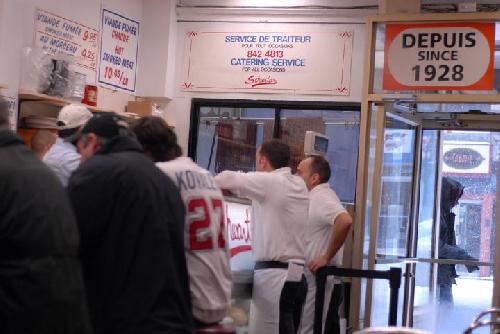The first mention of the bagel is in a 1610 text in a sumptuary law from the city of Krakow but in the late 19th century doughnut-shaped bread and smoked meat became popular in the New World thanks to successive waves of Jewish immigrants from Eastern Europe.
Why did Jews take up bagels in the first place?
"The addition of other ingredients besides flour and water makes them something other than bread," explains Olivier Bauer, a professor at the University of Montreal's Faculty of Theology and Religious Studies. "So Kashrut allows Jews to buy them and eat them right away without performing the ritual blessing over bread."
In his opinion, bagels have an important symbolic dimension, it attaches a conception of the divine because of its form which symbolizes the infinite.
Bauer is in Montreal and says there is a whole art behind the Montreal style bagel - distinct from its New York cousin, which is bigger and softer. The bagels are handmade: the dough is first briefly immersed in boiling water to which honey has been added and then baked in a wood-fire oven. "Montreal Jews developed a special way to prepare the ingredients taking into account the context in which the food was prepared. The result - a bagel with a firmer texture - is different from that found in Europe and the United States," said Bauer, who noted that an adaptation phenomenon also occurred with the cooking of smoked meat.

"Smoked meat is to Montreal what pastrami is to New York and corned-beef is to Toronto," says the travel guide Le Routard, which invites tourists to taste smoked meat served on rye bread in several well-known Montreal restaurants, including Schwartz's and Lester's, two delicatessens founded between 1919 and 1957.
So how did these delicacies find their way into popular culinary heritage? It's culinary hybridity. "Bagels and smoked meat are a hybridization of Jewish, central European, and North American cuisines," Bauer says, and the fact that most bagel bakeries in Montreal do not claim kosher certification is another sign of adaptation. "I'm not even sure that they're really kosher. Have you ever seen an orthodox Jew buy bagels on St-Viateur? I haven't!"
According to Bauer, it is precisely because bagels and smoked meat are no longer associated with a particular community that these foods have become the symbol they are today. He reminds us that at until recently, all Christian Montreal - Francophones and Anglophones - discriminated against Jews. He cited the fear expressed in the 1930s regarding the growing number of Jewish students at the University of Montreal and McGill University.
Bauer presented the results of his research at the international conference Food Heritage, Hybridity & Locality at Brown University, Rhode Island. His study is available on Papyrus.




Comments